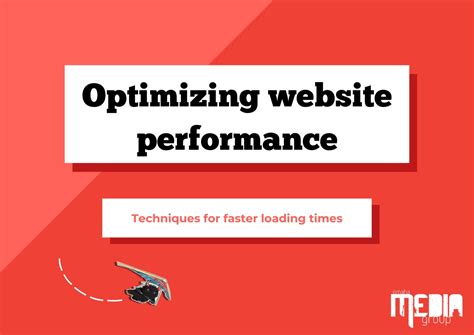Ever found yourself frustrated by a sluggish website, where every second feels like an eternity? You're not alone. In today's fast-paced digital world, where time is of the essence, optimizing your website's loading speed has become an essential task for any website owner or developer. However, fear not! There are numerous effective techniques that can propel your website towards lightning-fast loading times without breaking a sweat.
Streamline Your Web Content: When it comes to website performance, every byte matters. Minimizing the size of your web pages by optimizing and compressing your images, CSS, and JavaScript files can significantly reduce loading time. Utilizing modern image formats, such as WebP, and employing advanced compression algorithms can preserve image quality while simultaneously enhancing load speed.
Utilize Caching: Caching is a powerful technique that allows a website to store and serve frequently accessed data, improving overall page load speed. By implementing browser and server caching, you can effectively reduce the amount of data that needs to be transmitted, resulting in lightning-fast load times for repeat visitors to your website.
Enable Gzip Compression: Gzip compression is an invaluable tool that can drastically reduce the size of your web files before they are transferred to the user's browser. By enabling Gzip compression on your server, you can minimize file sizes by up to 70%, ultimately improving your website's loading speed and enhancing user experience.
Optimize Your Code: The efficiency and cleanliness of your website's code can have a significant impact on its overall performance. Utilize best practices such as removing unnecessary line breaks, whitespaces, and comments from your HTML, CSS, and JavaScript files. Additionally, consider minifying your code by removing unnecessary code elements and reducing file sizes, further optimizing your website's load speed.
By employing these fundamental strategies, you can transform your website into a well-oiled machine, delivering an exceptional user experience with lightning-fast loading times. Stay tuned for more insider tips and techniques to propel your website's performance to new heights.
Improve Image Performance for Faster Website Loading

Enhancing the efficiency of images on your website is essential for optimizing its speed and overall performance. By carefully managing the sizes of your images, you can significantly reduce page load times and enhance the user experience. This section will provide you with effective techniques to optimize image sizes without compromising on visual quality.
1. Resize and Crop Images: Adjust the dimensions of your images to match the required display size on your website. Crop any unnecessary portions to eliminate excessive file sizes. |
2. Choose the Right Image Format: Select the appropriate file format based on the type of image. Utilize JPEG for photographs, PNG for graphics with transparency, and SVG for scalable elements. |
3. Compress Image Files: Reduce the file size of your images by compressing them. Utilize compression tools or online services to maintain image quality while minimizing the file size. |
4. Lazy Loading: Incorporate lazy loading techniques to load images only when needed. This approach enhances initial page load speed by deferring the loading of images until they are visible to the user. |
5. Use Image CDNs: Utilize Content Delivery Networks (CDNs) to distribute image files across multiple servers globally. This reduces the distance between users and the server, resulting in faster image delivery. |
6. Minify CSS and JavaScript: By minifying your CSS and JavaScript files, you can reduce the overall file size of your website, leading to faster loading times for images as well. |
7. Implement Responsive Images: Ensure that your website incorporates responsive image techniques, allowing images to adapt to different screen sizes. This avoids unnecessary loading of large images on smaller devices. |
8. Optimize Image Metadata: Carefully manage and optimize image metadata. Remove any unnecessary data and ensure relevant information is properly described, reducing file size and improving load times. |
9. Implement Browser Caching: Enable browser caching to store previously loaded images on the user's device. This allows subsequent visits to your website to load images faster by retrieving them from the cache. |
10. Utilize Content Delivery Networks: Incorporate the use of Content Delivery Networks (CDNs) to distribute image files across multiple servers globally. This reduces server load and ensures faster image delivery to users worldwide. |
Enhancing Website Performance by Reducing HTTP Requests
When it comes to optimizing your website's performance, one crucial aspect to consider is minimizing HTTP requests. This strategy focuses on reducing the number of requests made by your website to the server, resulting in faster page loading times and improved user experience.
Avoiding excessive HTTP requests involves various methods such as combining multiple files into one, using CSS sprites, and minimizing the use of external resources. By implementing these techniques, you can significantly enhance the loading speed of your website, making it more efficient and user-friendly.
One effective approach is consolidating multiple files, including JavaScript and CSS files, into a single file. This helps reduce the number of HTTP requests, as browsers can retrieve all the required information from a single file rather than making individual requests for each one. Additionally, combining and minifying these files can further optimize the loading speed of your website.
Another method to minimize HTTP requests is by utilizing CSS sprites. By combining multiple images into one single image file and using CSS to display specific sections, you can reduce the number of requests made to the server. This technique is particularly useful for websites with numerous small images or icons that are used repeatedly throughout the site.
Furthermore, limiting the use of external resources can also contribute to reducing HTTP requests. External resources, such as external scripts, fonts, or social sharing widgets, require separate requests to load. Evaluating the necessity of these resources and minimizing their usage can significantly improve your website's loading speed.
In conclusion, optimizing your website's performance by minimizing HTTP requests is a vital strategy for enhancing page loading speed. By consolidating files, utilizing CSS sprites, and minimizing external resources, you can effectively reduce the number of requests made by your website, leading to faster loading times and a better user experience.
Improving Website Performance with Browser Caching

Enhancing the speed and performance of your website is crucial for providing a seamless user experience. One effective method to achieve this is by enabling browser caching. By leveraging browser caching, you can reduce the load time for returning visitors and improve overall site performance.
Browser caching involves storing certain files from your website, such as images, CSS, and JavaScript, on a visitor's device after the initial visit. When the visitor returns to your site, their browser can retrieve these stored files instead of downloading them again from the server. This significantly reduces the amount of data that needs to be transferred, resulting in faster page load times.
To enable browser caching, you need to instruct the visitor's browser on how long it should cache specific files. This is done through the use of HTTP headers, specifically the "Cache-Control" and "Expires" headers. The "Cache-Control" header specifies the caching rules that the browser should follow, while the "Expires" header sets an expiration date for cached files.
| HTTP Header | Directive |
|---|---|
| Cache-Control | max-age=3600, public |
| Expires | Sat, 01 Jan 2022 00:00:00 GMT |
By setting appropriate values for these headers, you can control how long browsers will cache your files. For example, specifying a max-age of 3600 seconds (1 hour) indicates that the file should be cached for that duration. The "public" directive allows the file to be cached by both the browser and intermediary caches, such as proxy servers, further optimizing the delivery of your content.
It's important to note that browser caching works best for static resources that do not change frequently. Dynamic content, such as user-specific data or real-time updates, should not be cached to ensure informational accuracy.
Enabling browser caching can significantly improve your website's load time and overall performance. By reducing the amount of data that needs to be transferred between the server and the visitor's browser, you can create a faster and more efficient website experience for your users. Implementing HTTP headers, such as "Cache-Control" and "Expires", is a crucial step in optimizing browser caching and maximizing the benefits it offers.
Enhance Performance with Content Delivery Networks (CDNs)
One effective approach to elevate the efficiency of your website is by utilizing Content Delivery Networks (CDNs). CDNs present an optimal solution for enhancing the delivery speed and performance of your website content to users across the globe.
A CDN is a distributed network of servers located in various geographical locations. When a user visits your website, the CDN automatically determines the server that is closest to their location. This ensures that the content is delivered swiftly, reducing latency and load times.
By leveraging CDNs, you can minimize the distance between your website's server and the user, enabling faster data transmission. This can significantly enhance the overall browsing experience for visitors, ensuring that they get instant access to your content.
CDNs are particularly beneficial for websites that have a global audience. Instead of relying solely on a single server to deliver content to users worldwide, CDNs distribute the load across multiple servers. This helps to handle high traffic volumes and ensures that each user receives a fast and responsive browsing experience, regardless of their location.
Not only do CDNs improve the speed and performance of your website, but they also contribute to reducing the strain on your server. With a CDN in place, your server can offload a significant amount of data transfer requests to the CDN network, allowing it to focus on other critical website processes.
To fully benefit from CDNs, ensure that your website's static files, such as images, CSS, and JavaScript, are stored and delivered through the CDN network. Additionally, regularly monitor and optimize your CDN configuration to ensure optimal performance and reliability.
| Advantages of Using CDNs |
|---|
| 1. Faster content delivery |
| 2. Reduced latency and load times |
| 3. Improved browsing experience for global users |
| 4. Efficient handling of high traffic volumes |
| 5. Offloading data transfer requests from your server |
Enhance Performance of CSS and JavaScript

Optimizing the efficiency of your website's CSS and JavaScript plays a vital role in improving its overall performance. By making some key adjustments to these elements, you can significantly enhance the loading speed and user experience of your website.
- Minify files: Minifying your CSS and JavaScript files involves removing unnecessary characters, white spaces, and comments. This reduction in file size helps to reduce the loading time of your website.
- Combine files: Combining multiple CSS and JavaScript files into a single file reduces the number of HTTP requests made by the browser, resulting in faster loading times.
- Implement asynchronous loading: Utilizing asynchronous loading for CSS and JavaScript files allows them to load simultaneously without blocking other elements on the webpage. This technique enhances the loading speed and ensures a smoother user experience.
- Load files from a CDN: Loading CSS and JavaScript files from a Content Delivery Network (CDN) can significantly improve the loading speed of your website. CDNs distribute files across multiple servers, reducing the distance between the user and the server and therefore reducing latency.
- Optimize CSS delivery: It is important to optimize the delivery of CSS files to prevent render-blocking. Techniques such as inlining critical CSS and deferring non-critical CSS can help improve page load speed.
- Strategically place JavaScript: Placing JavaScript files at the bottom of your webpage allows the browser to first load the content and layout before executing the JavaScript, resulting in a faster perceived loading speed for users.
- Eliminate render-blocking JavaScript: Identifying and removing or deferring JavaScript that blocks the rendering of the webpage can significantly improve the page load speed.
- Lazy loading: Implementing lazy loading for non-critical CSS and JavaScript files ensures that they are only loaded when needed, reducing the initial loading time of your website.
- CSS/JS caching: Enabling caching for CSS and JavaScript files allows returning visitors to retrieve these files from their local cache, speeding up subsequent page loads.
- Regularly update and optimize: Keeping your CSS and JavaScript files up to date and optimizing them by removing unused code can help improve loading speed and overall website performance.
By implementing these optimization techniques for your website's CSS and JavaScript, you can significantly enhance the loading speed and performance, providing a better user experience for your visitors.
FAQ
Why is website page load speed important?
Website page load speed is important because it directly affects user experience. A slow-loading website can lead to increased bounce rates, lower conversions, and dissatisfied visitors. Additionally, search engines like Google consider page load speed as a ranking factor, so a faster website can also improve your search engine visibility.
How can I measure my website's page load speed?
There are various tools available to measure your website's page load speed. Some popular options include Google PageSpeed Insights, GTmetrix, and Pingdom. These tools provide detailed reports and recommendations to improve your website's speed performance.
What are some common factors that affect website page load speed?
Several factors can affect website page load speed, including large image file sizes, excessive HTTP requests, poor server performance, unoptimized CSS and JavaScript code, bulky web page elements, and lack of caching. These factors can slow down the loading time and should be addressed to improve the speed of your website.
How can I optimize images to improve page load speed?
To optimize images for faster page load speed, you can compress them using image compression tools or plugins. Additionally, you can choose the appropriate file format (JPEG, PNG, WebP) based on the image content and use responsive image techniques to serve the right size of the image for different devices.
Are there any content delivery networks (CDNs) that can help improve page load speed?
Yes, there are several content delivery networks (CDNs) available that can help improve page load speed. CDNs distribute your website's content across multiple servers in different geographical locations, reducing the distance between the user and the server, resulting in faster content delivery. Some popular CDNs include Cloudflare, Amazon CloudFront, and Akamai.
Why is page load speed important for a website?
Page load speed is important for a website because it greatly affects user experience. Faster loading times enhance user satisfaction, increase engagement, and decrease bounce rates. Additionally, search engines like Google consider page load speed as a ranking factor, so a slow website may also lose visibility in search results.
What are some common factors that slow down website's load speed?
There are several common factors that can slow down a website's load speed. These include large image file sizes, excessive HTTP requests, poor server performance, unoptimized code, lack of caching, and the use of unnecessary plugins or scripts. These factors can be addressed and optimized to improve a website's page load speed.



